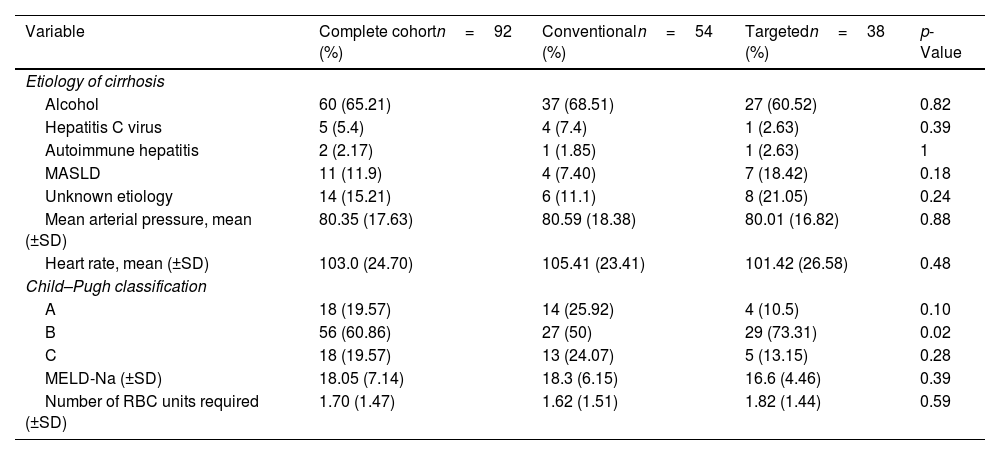Endoscopic band ligation (EBL) standard therapy is traditionally performed with banding from the distal esophagus upwards. However, esophageal varices (EV) with stigma of recent bleeding are not consistently banded at the first attempt. We aimed to compare conventional banding in acute variceal bleeding (AVB) vs targeted banding of EV in patients with stigma of recent bleeding (white nipple sign).
MethodsThis case–control study included patients treated in our hospital from December 2016 to September 2019 with endoscopic signs of recent variceal bleeding. The targeted technique involves deploying the first band at the recent bleeding stigmata and then completing the procedure with standard variceal banding technique. The conventional group included patients treated with standard EBL.
ResultsWe analyzed 92 patients, 54 (58.7%) in conventional technique and 38 (41.3%) in the targeted group. Active bleeding during endoscopy occurred in 11 (20.0%) of conventional and two (6.5%) of the targeted group (p=0.021). Although procedure time was longer in the conventional group (24.3min SD 11.58) compared to the targeted group (21.52min SD 8.73) this difference was not significant. One detached band episode was documented in targeted group and none in the conventional group (p=0.418). TIPS were not used during this study due to health system policy. There were no significant differences in mortality, rebleeding or transfusion requirements between groups.
ConclusionsThe targeted technique for EV with stigma of recent bleeding had a low band detachment incidence and fewer bleeding events during endoscopy, however, the limitations of the study should be considered.
La terapia estándar de ligadura endoscópica (LBE) se realiza desde el esófago distal hacia arriba. Sin embargo, las varices esofágicas (VE) con estigma de sangrado reciente no se ligan sistemáticamente al primer intento. Nuestro objetivo fue comparar la ligadura convencional en la hemorragia aguda por varices esofágicas (SAV) frente a la ligadura dirigida en pacientes con estigma de sangrado reciente (signo del pezón blanco).
MétodosIncluimos pacientes tratados en nuestro hospital desde diciembre de 2016 hasta septiembre de 2019 con signos endoscópicos de sangrado variceal reciente. La técnica dirigida consiste en aplicar la primera liga en el estigma de sangrado reciente y posteriormente completar el procedimiento con la técnica estándar. El grupo con técnica convencional incluyó pacientes tratados con LBE estándar.
ResultadosAnalizamos 92 pacientes, 54 (58,7%) con técnica convencional y 38 (41,3%) con ligadura dirigida. La hemorragia durante la endoscopía estuvo presente en 11 (20,0%) del grupo convencional y 2 (6,5%) de ligadura dirigida (p=0,036). El procedimiento requirió mayor tiempo en el grupo convencional (24,3min; DE: 11,58) vs. grupo de ligadura dirigida (21,52min; DE: 8,73), sin diferencia significativa. Se documentó un episodio de liga desprendida en la terapia dirigida y ninguno en el grupo convencional, (p=0,418). No se realizó TIPS debido a cuestiones socioeconómicas. No existieron diferencias entre grupos en mortalidad, resangrado o transfusiones.
ConclusionesLa técnica dirigida tuvo una baja incidencia de desprendimiento de liga y menos eventos hemorrágicos durante la endoscopia; sin embargo, se deben considerar las limitaciones del estudio.












